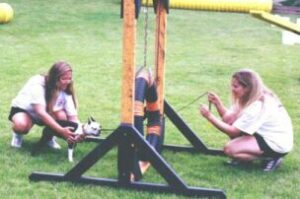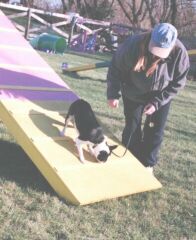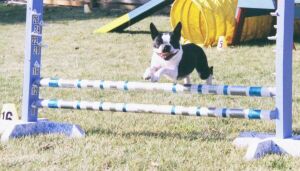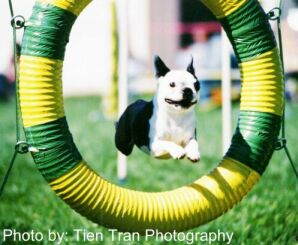By Kathy Edstrom

As a pet dog owner, I enjoy the sport of Agility for pure fun. I currently don’t compete with my dogs, but take great pleasure in spending quality time with them training in Obedience and Agility. Canines are a fascinating species, and very intelligent. Just because you don’t have an interest in competing with your canine companion, doesn’t mean you can’t train them in various sports.
With a positive approach, you and your dog can have a great time learning how to work as a team, and at the same time, provide mental and physical stimulation for both you and your pet dog. Deb Chvilicek of Happy Feet K-9 Agility in Oak Creek, Wisconsin has been involved with the sport of Agility and Obedience for over six years with her Boston terrier, Roy. She has been an instructor of Agility for five years, providing private and group lessons. Deb says she pursued Agility because it looked to be a way to have some fun with her dogs.

According to Deb, “Agility is much different than Obedience. You can talk to your dog the whole time you are working and training. Agility becomes a game for dogs. When training, the dog receives lots of praise and interaction with their owner.”
Deb went on to explain the history of Agility and her method of teaching this canine sport.

“Agility is the ability to move or think quickly and easily. It is probably the most interactive fun you could possibly have with your canine companion. Agility is an obstacle course of tunnels, jumps, ramps, pole weaving, table stopping, and hoop jumping fun!
This sport began in Great Britain in 1978 as a demonstration at the most prestigious Crufts dog show. The show committee wanted a way to fill in the spaces between Obedience and Group judging. John Varley and Peter Meanwell from the show committee came up with Dog Agility; borrowed from the idea of equestrian events. The fast pace, pure joy for the dogs was enough for the spectators to see this was going to be one of the most contagious new sports for dogs.
The United States jumped into the fun in the early 1980’s. From there the rest of us caught the bug and have spread it quickly. Agility has taken off so well in the US that Obedience has taken a back burner.

Why has agility taken off so well? Because it is such a great way to really bond with your dog. They learn by following your body language. Something dogs were born to do.
When you start to teach yourself and dog how to maneuver the course and obstacles, it is incredible to see the light go on in the dog’s head when they ‘get it’. Dogs become more confident with their own body placement, we become more aware of our ability to do things. I myself am much more confident in an Agility ring than an Obedience ring.
The best part of working in Agility is that it is open to all dogs; mixed, rare, and pure breeds. All those over sized or under sized breed dogs are very welcome. At this point AKC is the only organization that does not allow mixed breeds or rare breeds not recognized by them to compete in their performance sports.”

What type of approach does Deb Chvilicek take when teaching agility? “When I’m training in Agility, I use a positive approach. The key to success is to have the dog think it is their idea. When teaching each piece of equipment, the student is not allowed to talk to the dog other than saying, ‘YES’ to mark the desired behavior. Then they can party with the treats or toys. During training, dogs must wear a buckle collar with a tab (a short leash or cord). The tab is an extension of your arm in case the dog should need help, i.e. starting to slip/fall off equipment. Dogs are NEVER forced, dragged or treated in a manner that would frighten them.
I do not use a different technique to teach competition or companion pets. When competing, you should work your dog no different than training your dog. I encourage my students to strive for success and to move at a pace that best suits each individual. My number one goal in teaching is safety, keeping in mind that dogs do not ask to come and do Agility. (Well, not at first. Students have said that if they drive past my home with their dog, the dog will get very excited.) I hope 100% of my students are training for fun, but about 75% of them take their fun with their dog into the trial ring.” I asked Deb if she worked with pet owners whose dog had emotional issues, and if Agility helped to resolve those issues. Deb shared these examples. “I do have a few students who come for various reasons. Some dogs have confidence issues. Agility helps them to learn to have some fun without any pressure. A few dogs need the aerobic exercise that Agility offers for health reasons, and to be in great shape for the breed ring. I also had a younger student who has ADHD (Attention Deficit Disorder with Hyperactivity). Agility has helped her learn to stay on task and release some of her excess energy. (It made her parents happier too.) Agility can help build a closer bond with your dog as you are working and learning together. The dog thinks this is so cool that their owner will play with them nonstop for 30 minutes.
I asked Deb if she worked with pet owners whose dog had emotional issues, and if Agility helped to resolve those issues. Deb shared these examples. “I do have a few students who come for various reasons. Some dogs have confidence issues. Agility helps them to learn to have some fun without any pressure. A few dogs need the aerobic exercise that Agility offers for health reasons, and to be in great shape for the breed ring. I also had a younger student who has ADHD (Attention Deficit Disorder with Hyperactivity). Agility has helped her learn to stay on task and release some of her excess energy. (It made her parents happier too.) Agility can help build a closer bond with your dog as you are working and learning together. The dog thinks this is so cool that their owner will play with them nonstop for 30 minutes.
One of my students’ came to me just wanting some fun with her dog. The only problem was the dog would run away if taken off leash and wouldn’t come back when called. This dog was tied up in a fenced in yard! After a few short lessons, the dog saw the benefit of coming to ‘Mom’ rather than running off. It has been three years of summer-only lessons, and this dog can now go for walks off leash with the owner. The dog is always looking to ‘Mom’ for more to do and does not even think of leaving. They will never go into the ring to compete, but the bond they now have is incredible!”
According to Deb, you can start training your dog in Agility at any age as long as you keep in mind the limitations of a puppy or an older dog. She also recommends not training your dog in Agility if there are health issues, or if your dog does not like agility. Deb noted, “Some dogs really do not like Agility and should NEVER be forced to do it.”
“I really enjoy watching the people and dogs succeed in working together as they accomplish each week’s challenge of the lesson. As the weeks pass, you can see them become a closer team. When some of them decide to trial, it is a pleasure to watch them succeed.”
About Deb
Deb Chvilicek, owner of Happy Feet K-9 Agility, is located in Oak Creek, WI. She provides 30-minute private lessons, and 50-minute group training sessions with a maximum of 6 dogs per class. Outdoor lessons are offered weekly for individuals and groups during the summer months only.
Deb and her husband Dave have a son, Dan; two Boston terriers, Roy and Ann; an Appaloosa Horse named Chief; seven cats, Woody, Uddy, Zuddy, Footy, Sooty, Booty, Thuddy and many Bantam chickens. They reside in Oak Creek, Wisconsin
Deb has been training in Agility since 1995. Her first trial with Roy was in 1997 -a “Fun On The Run” NADAC Trial. That was also the first of their qualifying legs. Roy took two 1st Place ribbons, two 2nd Place ribbons, and one-3rd Place ribbon that weekend. Deb noted that was also the weekend they came home and started to build their own equipment that soon turned into she and Dave’s Agility school, “HAPPY FEET”.
Since that first trial, Deb and her canine friend Roy have successfully competed in AKC, UKC, NADAC, ASCA and USDAA. Roy also has a few Obedience titles, and finds a little time to do some therapy work.
Ann, the second Boston terrier joined the Chvilicek household later in her life after her owner passed away. Ann is Roy’s niece. She was older, 1-½ years old and had no training when she came to live with them. Ann does have a few Agility titles. Her biggest problem according to Deb is she is a real social butterfly. Ann does great, but sometimes forget she is working and has the urge to visit the judge or photographer.
Deb Chvilicek and her two Boston terriers’ Accomplishments:
UACHX, UCDX Foxfire’s Roy TT, TDI, CD, MX, MXJ, AAD, EAC, EGC, EJC, ASAC-CDX, RS-N, JS-N (9/23/94) U-AGI Foxfire’s Agile Ann NA, NAJ (12/2/97)

